The Top 8 Phaser Pedals – Essential Effects That You Should Try
We may also earn commissions on purchases from other retail websites.
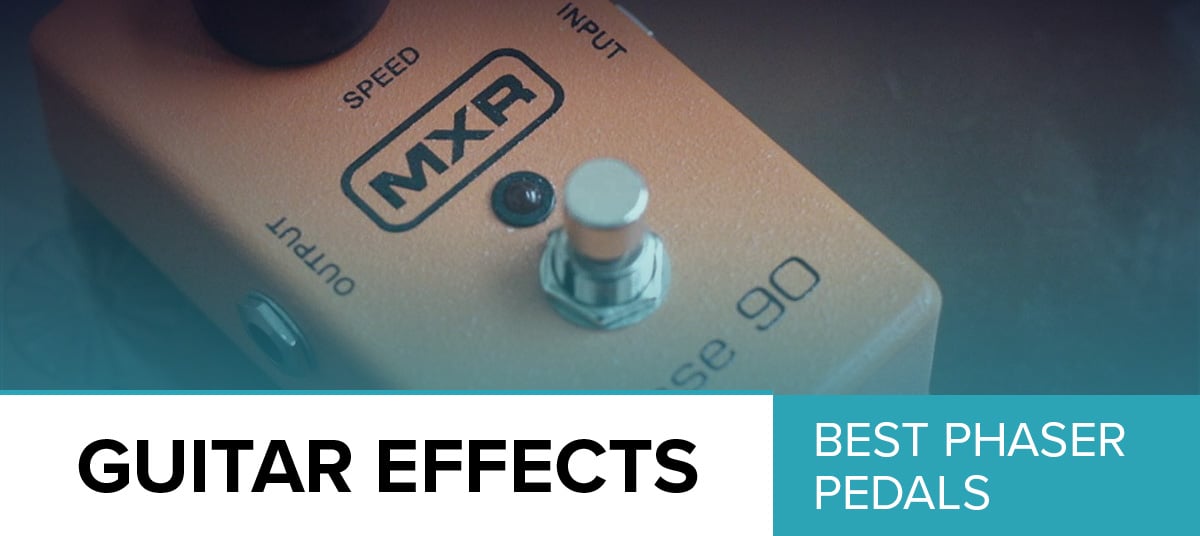
Last Updated Nov-03-2018.
Guitar effects can be simple or complex, depending on what kind of tone you are after. When it comes to phasers, they belong to the former category. Today we are going to show you some of the best phasers on the market, but even more importantly, explain what this guitar effect is all about.
Considering how phasers are among the most influential guitar effects in existence, our guide has a lot of ground to cover. By the time we are done, you should have a complete theoretical understanding of phasers and good idea of how they can help your tone.Top 8 Phaser Pedals
| Image | Guitar Pedal / Rating | Summary | Check Price |
|---|---|---|---|
+ -  | MXR Phase 90 Total of 4.82/5 | A truly legendary phaser pedal that is still among the best today. | |
+ -  | Boss PH-3 Total of 4.92/5 | In terms of versatility, this Boss pedal ruled for a long while. | |
+ - 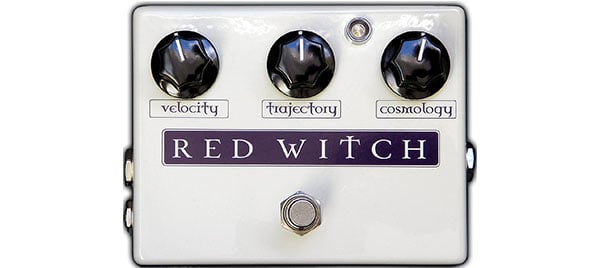 | Red Witch Analog Deluxe Moon Total of 4.75/5 | Unusual boutique design that brings a new take on the phaser effect. | |
+ -  | DigiTech SP-7 Hardwire Total of 4.85/5 | Well made and incredibly capable phaser that delivers on all fronts successfully. | |
+ -  | DOD Phasor 201 Total of 4.88/5 | Quality revamp of the legend that started the modern phaser pedal segment. | |
+ -  | MXR M107 Phase 100 Total of 4.80/5 | Upgraded and beefed up MXR Phase 90 with more controls and features. | |
+ -  | Ibanez PH7 Phaser Pedal Total of 4.80/5 | Ibanez raised the stakes by adding new controls, and bringing quality performance. | |
+ -  | TC Electronic Helix
Total of 4.95/5 | The ultimate model for those who like to alter the effect's core. |
MXR Phase 90
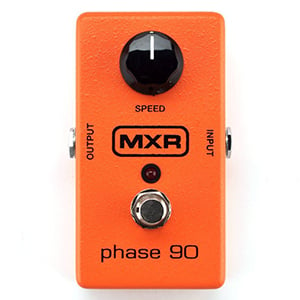
| Controls: |  |
| Features: |  |
| Performance: |  |
| Value: |  |
Starting this list with any other model would just be wrong. MXR takes the cake for the number one spot on our list with one of its most prolific models. Phase 90 is a classic analog phase shifter that has been around for a while now. At one point it became a really popular pedal among most of the popular guitar players of the ’70s. One of the best things about this particular model was its simplicity.
MXR didn’t really want to waste too much time by trying to squeeze in various features and controls. No, they went straight to the business. The design of the pedal is rather simple and entails a small orange box with a single knob which has ‘Speed’ written bellow it. As you can probably guess, the Speed relates to the frequency of the phase filter, and that was about all you could control.
We are so used to complex new pedal circuits that we keep forgetting just how great it is to have a basic design such as this one. Add a great tone to the mix, and you have yourself a recipe for success. Overall, a great pedal that is still going strong.
Boss PH-3
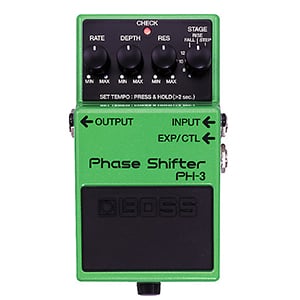
| Controls: |  |
| Features: |  |
| Performance: |  |
| Value: |  |
Boss being Boss, you know they just have to spice things up. Compared to most standard phasers, PH-3 brings a lot more versatility to the table. For the most part, it is this trait that has brought it a lot of popularity from the moment it was released. On a first glance it looks like any other Boss pedal, but this phaser is anything but ordinary.
Aside from allowing you to adjust the speed of the effect, you also get to adjust the depth of the ‘dips’ as well as the resonance. But wait, there’s more. One of the most important aspects of Boss PH-3 phaser pedal is the fact that it allows you to choose the number of stages. You have 4,6,8 and even 12 stage phaser to play with, along with some other modes which are a bit more specific.
At the end of the day, Boss PH-3 is the type of phaser you can dial in the way you want to for each distinct scenario. The newer models even come with a tempo detect feature. This is a little green box of swirly goodness that just keeps on giving.
Red Witch Analog Deluxe Moon
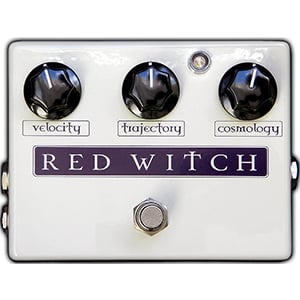
| Controls: |  |
| Features: |  |
| Performance: |  |
| Value: |  |
Boutique pedals are bound to be more refined than the usual stuff we have available. After all, that’s why they come at a higher price. Red Witch Analog Deluxe Moon is a very phaser box that packs a tone rarely found elsewhere. The whole point of this unit is to deliver that vintage analog color in a more modern package.
There is one twist to this story. Red Witch Analog Deluxe Moon is not just a phaser, it is also a tremolo pedal. Compared to some of the most popular tremolo pedals, Red Witch Deluxe Moon carries its weight just fine.
In short, you get a combo of two effects which both sound great in this particular format. The only thing to keep in mind is that you will definitely need to pay a bit extra for the pleasure of owning a Red Witch Analog Deluxe Moon. Whether or not it’s worth the investment is completely up to you, but it is one of the best sounding phasers on the market at the moment.
DigiTech SP-7 Hardwire
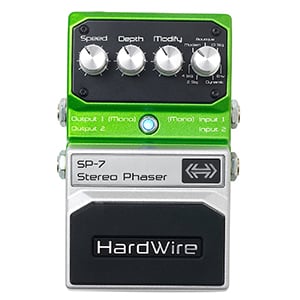
| Controls: |  |
| Features: |  |
| Performance: |  |
| Value: |  |
If you have been involved with guitar effects for any reasonable amount of time, you probably know about DigiTech. The type of impact this company had in the world of music is not something many brands can brag about. While SP-7 Hardwire isn’t their best model ever, it’s definitely among the ones that keep this brand popular.
In terms of design, DigiTech SP-7 Hardwire is pretty robust. The stompbox is made to take good amounts of abuse if that’s what you need to do, which is comforting if you plan to use this thing on stage. The pedal comes with a similar set of controls as the PH-3 we just mentioned. As a matter of fact, in terms of layout and appearances, they are pretty similar. DigiTech SP-7 Hardwire comes with 10 available stages and depth/resonance/speed control cluster.
Tap tempo is also there, but unlike the PH-3, SP-7 comes with stereo output capability. That alone is why this awesome pedal is worth checking out. In terms of tone color, you are looking at a clinical, but also organic phaser effect. Overall, DigiTech SP-7 Hardwire is among the top-value deals at the moment.
DOD Phasor 201
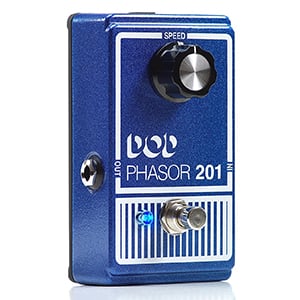
| Controls: |  |
| Features: |  |
| Performance: |  |
| Value: |  |
When it comes to modulation effects, you will always have those who prefer older analog circuits, and those who love the new digital stuff. Guitar players who fall into the former category will definitely know who DOD is as a brand, and they might even know about the Phasor 201. DOD was among the first companies on the market to produce a compact phaser that was both small and offered a good effect.
Phasor 201 is a reissue of their vintage classic, and it’s every bit as good. The design is rudimentary in a sense that there is only one knob to work with. However, that was normal for the analog phasers back in those days. The pedal itself offers one of the most recognizable phase effects which is still very much competitive today.
Sure, it’s not the cheapest thing out there, but DOD Phasor 201 is definitely among some of the most iconic effects pedals ever made. A lot of people approach it with skepticism only to be completely taken by surprise when they realize just what an old analog circuit is capable of doing. Definitely a model worth checking out.
MXR M107 Phase 100
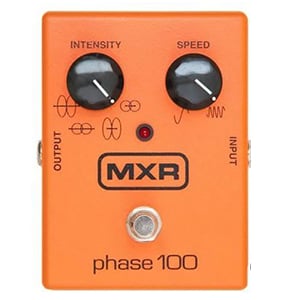
| Controls: |  |
| Features: |  |
| Performance: |  |
| Value: |  |
We have already covered the famous Phase 90 by MXR, but now it is time to look at the model which came as a successor. Phase 100 comes in a larger format and offers a bit more than just the Speed control we are used to seeing on Phase 90. The color of the pedal is the same, and even the tone right about there somewhere. However, with the Phase 100 you get to choose the intensity of the phaser, thus adding another dimension to an already proven platform.
All of this might sound a bit bland compared to the more modern digital models, but keep in mind that we are talking about an analog unit. The device’s vintage nature is exactly what keeps people coming back to the legendary orange box.
Some prefer the simplicity of Phase 90, but other know just how much that additional knob means in terms of control and versatility. The pedal is big and might give you some trouble when it comes to fitting it on a pedal board. With that said, this one is absolutely worth the effort no matter what.
Ibanez PH7 Phaser Pedal
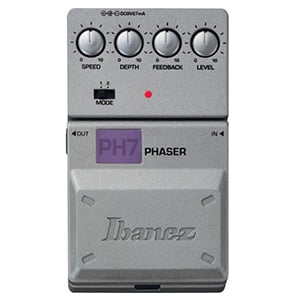
| Controls: |  |
| Features: |  |
| Performance: |  |
| Value: |  |
After producing one of the most legendary overdrive pedals in the history of guitar effects, people got used to Ibanez delivering good pedals from time to time. The one we are talking about today is the Ibanez PH7 Phaser. One quick glance at this thing will tell you that you’re looking at more or less the same layout as just about any other phaser on the market.
However, there’s a big difference here. Aside from you standard three controls which let you adjust the speed, depth, and feedback, Ibanez PH7 allows you to control the level of the output as well. What exactly does this mean in practical terms? Standard phasers are great for general purpose use, but not when you’re trying to be as subtle as possible.
Achieving this is something that that simply requires a level control knob. On top of that, Ibanez PH7 is among more natural sounding ‘modern’ phasers you can find at the moment. For a unit that is not nearly as flashy as some on the market, this Ibanez sure is holding its ground.
TC Electronic Helix
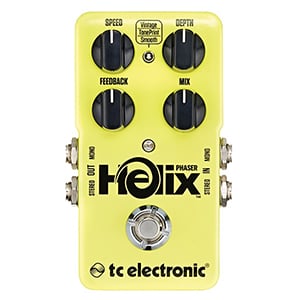
| Controls: |  |
| Features: |  |
| Performance: |  |
| Value: |  |
Helix from TC Electronic is more or less what happens when you bring an already popular concept to a new age. Phasers are not that complicated from our standpoint, but not a lot of brands tried to impact the way they worked within their core. Except for TC Electronic.
This pedal shop is known to release some of the most outrageous, but also most impressive pedals on the market. Similar can be said about the Helix. So what’s that different? Let’s start with the fact that this is an effects pedal you can customize using TC Electronic’s proprietary software.
In a way, this allows you to achieve just about any phaser effect type you can think of. With that said, the pedal itself features the more or less standard controls, only you also get true bypass as well as dual inputs and outputs for stereo use.
What Is A Phaser Effect?
Guitar effects can be divided into several categories. The one phasers belong to are called modulation effect. If we were to translate this fancy speak into something more understandable, we could say that modulation effects impact modify the signal coming out of the guitar by altering its frequency, pitch and more. It is worth noting that phasers are among the oldest modulation effects as well. Even though that piece of info isn't too important for our discussion today, it's just something that helps put this effect into proper context.
With all that said, let's figure out what a phaser really is. At its core, a phaser is nothing more than an oscillator circuit that is packet with all pass filters. If you think about it, it is a very simple and genius solution that results in a pretty awesome sound effect. When you slap all of those filters to an oscillator, you get a sweeping type effect. Each filter blocks out a certain portion of frequencies in your signal, thus creating that weird, spatial dimension to your tone.
We might have oversimplified this explanation a bit, but the point is there. On a similar note, this describes a pretty basic phaser, which is much closer to older designs. As you could imagine, the modern ones are a bit more advanced.
Analog Or Digital Phasers?
Before we get into specifics of modern phasers, we have to touch upon the two general types of these pedals you will run into. Much like most pedals these days, you will find analog and digital versions. Which one is better? Well, that depends on a number of factors, including your taste and budget. It is fair to say that analog phasers sound a bit more organic than their digital counterparts, while the latter bring more bang and versatility at lover prices.
A good way to start is to get something like MXR's Phase 90. This is a super simple analog phaser. Not only will you have access to one of the most legendary phaser effects if you choose to get it, but it is also extremely simple to use. This in turn will help you get to know the effect much better since there aren't many variables to concern yourself with.
Are Phasers The Same As Flangers?
One of the biggest misconceptions regarding phasers is that they are almost the same, if not the same thing as flangers. While it is easy to see why someone would think that, these two effects are very much different. If you want to learn more about flangers, go ahead and check out our dedicated guide for that guitar effect. To give you a short answer, flangers create a type of Doppler effect similar to that of a train coming towards you and then moving away. It does that by adding an ever so subtle amount of delay to the signal. When you put both effects side by side and add only a small amount of each, it is really hard to tell the difference if you were not familiar with them before hand. Each has their time and place, but knowing the difference can solve you a bit of trouble down the road.
How Versatile Are Phasers?
Whenever you are learning about a new guitar effect, it is only logical to question its practical value. There are some pretty crazy guitar effects out there which are more or less useless in every day life. With phasers, that is not the case. If you were to actually go over some songs where phasers are used, you will find that there are example of just about every genre that utilizes electric guitars.
The catch is to master the intensity and to know how much is enough for any given riff or section. That's the cool thing about phasers. You can dilute them and add a subtle flavor, or you can crank it up to 11 and make it a dominant theme. It is by far one of the most versatile modulation effects you can get, and one many guitar players choose as their starter pedal.
Where Do Phasers Make The Most Difference?
Just like many other types of guitar effects, phasers are not something you want to have turned on all the time. There is a time and a place for a phaser. Naturally, how and where you use them will depend on the genre of music you are playing, but there are still some universal guidelines and unwritten rules.
For example, phasers have been and still are traditionally used to enhance solo sections. The reason for this is multi-faceted. It is not only about the swirling effect, especially considering how subtle most guitar players like to dose it. It is about adding some girth to the tone as well. One of the masters of phasing solos is none other than Van Halen. He basically revamped the phaser in this context, which is a trend that's healthy even today. Adding a bit of phasing in a solo is used in anything from grunge to nu metal and there are hundreds of songs that prove this.
Additionally, you can use phasers to enrich your clean chord progressions as well. Clean sections are not something you generally want to over saturate with effects, but phasers have proven to be just the perfect tool for the job.
Things To Consider When Using A Phaser
So far we have established that phasers are among the more basic modulation effects, but that doesn't mean they are simple to use. There are still some important rules that you need to follow if you want to get the best performance out of your new pedal.
The very first and most imperative thing you want to nail is timing. Since phasers have that wave function due to the oscillator inside, timing becomes a crucial metric to setup. This is where modern phasers have proven to be more effective. Most of them come with tap tempo feature which allows you to tap out the speed you want to use. If you have a more basic model, this is something you will have to dial in manually. The knob we will want to use to get this done is Speed, which is sometimes labeled as Rate.
Manually setting up the rate of a phaser is every bit as art as it is exact science. Sometimes you can do it, other times you might be just a tad off no matter what you do. What matters is to bring the speed to the closest possible vicinity of your song's tempo. It doesn't have to be perfect, but it needs to be as good as you can do it.
The very best way to get started is to make adjustments in very small increments. Especially if you have a more advanced versions with elaborate controls. Take your time to learn how the pedal responds to input and you will find that perfect setting soon enough.
Is A Phaser A Good Beginner Effects Pedal?
If you were to ask us this question, we would have to say yes, but with a disclaimer. It is a good beginner pedal in terms of modulation effects, but you should probably get a decent overdrive or distortion first. As a starter modulation effect, it doesn't get more old school that this. It is an easy effect to master and it brings more benefits than just its interesting flavor.
Let's say you took our advice and got a simple analog phaser like the MXR Phase 90. If you look at that pedal, you will see that there are only two controls available. These are the foot switch and the speed knob. By mastering a simple model like this one, you will learn how to adjust the speed of the effect to match the music you are playing. That skill can later be used on other guitar effects which have a similar wave function. Closest one is naturally the flanger, but there are others as well.
In that sense, phasers are great beginner modulation pedals. The other benefit of starting with a phaser is its sheer versatility. You can use it in just about anywhere while the range of intensity even the most basic model offers is enough to give you an abundance of options.
Conclusion
There are many reasons why phasers are one of the most popular guitar effects, even though they are among the oldest. We hope that the info we have given you above has answered at least some of the questions you have had about phasers. The more you learn about them, easier it is to see just how practical they are. If you are wondering which model to go with, the ones we have listed above are by far some of the best you can get right now. We have included picks that match different budgets, so there's something for everyone.


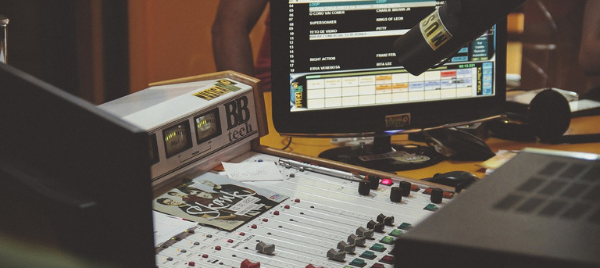
Reader Interactions